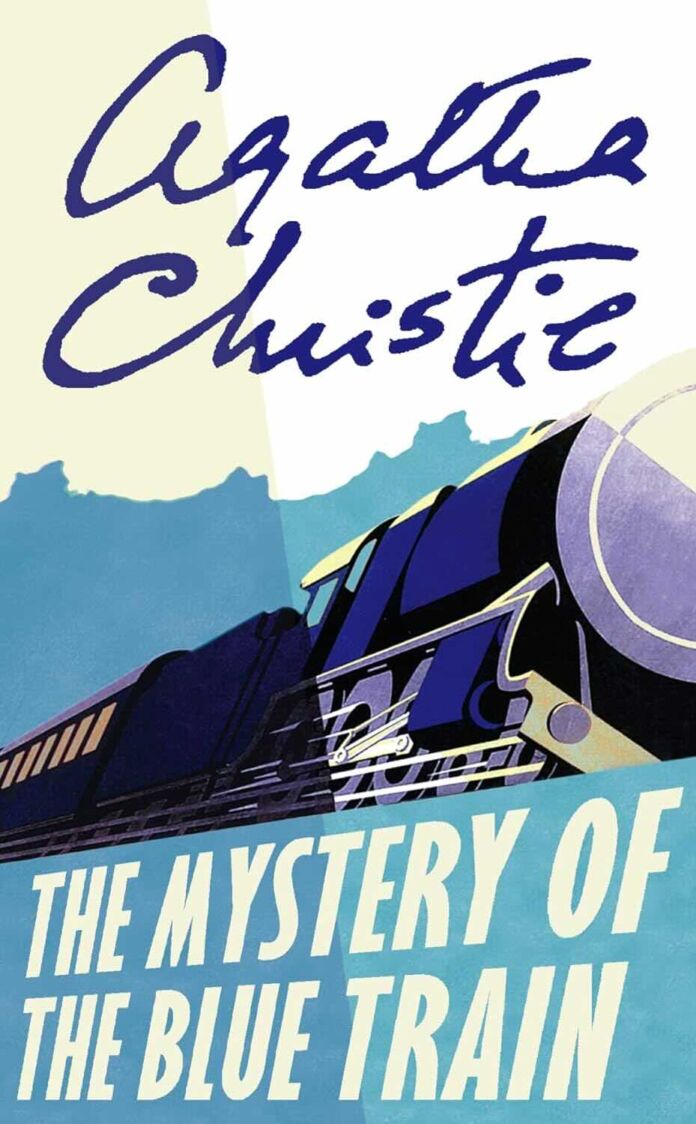When fabulously wealthy American heiress Ruth Kettering trades in her unhappy marriage to embark on an ill-fated elopement with her longtime lover aboard the luxurious Blue Train to the French Riviera, a deadly turn of events awaits. After her brutal murder en route, the case falls to none other than the illustrious Belgian detective Hercule Poirot. With a traincar full of suspicious characters and scandalous scenarios to investigate, Poirot’s “little grey cells” are put to the ultimate test in one of Christie’s most tightly-plotted early mysteries.
The Deliciously Devious Setup:
It’s 1928, and Agatha Christie was just hitting her prolific stride writing whodunits starring her beloved eccentric investigator Hercule Poirot. On the heels of acclaimed capers like The Murder on the Links and The Mysterious Affair at Styles, The Mystery of the Blue Train represented the Queen of Mystery operating at the peak of her abilities to craft finely-tuned plots teeming with potential suspects, simmering intrigue, and startling twists.
The setup seems simple enough – Ruth Kettering, the sole heir to a massive American fortune, has boarded the glamorous Blue Train for the French Riviera against her father’s wishes. She’s traveling under an assumed name with the intent of brazenly eloping with her longtime love Count Armand de la Roche. Decked out in millions of dollars’ worth of ruby jewels gifted by her indulgent father, Ruth is a tantalizing target for fortune hunters and murderers. Sure enough, on the train’s inaugural night she meets a grisly fate in her sleeping cabin car.
From the outset, Christie presents us with an array of potential killers, from Ruth’s embittered husband Derek to the dashing, slyly flirtatious Count to the enigmatic Yugoslav dancer traveling alone. Despite appearances being established from the colorful suspects’ inner thoughts and memories, every person in the ensemble cast proves harboring ulterior motives and shady dimensions that complicate their potential as the killer.
And presiding over this bewildering cavalcade of deceit is none other than Hercule Poirot himself. Though supposedly taking a vacation and stumbling upon the murder by chance, the legendary Belgian detective can’t resist the allure of re-entering the game. But unlike dusty Holmesian gentleman sleuths who delineate the truth from on high through penetrating deduction, Christie’s Poirot hilariously styles himself as the consummate ringmaster repeatedly flummoxed by each turn of the case’s complexities.
Throughout the novel, Poirot bounces from one blind alley of suspicion to the next while the reader must reconsider their assumptions about each character. Masterfully deploying red herrings, near misses, and revelatory bombshells about the eclectic ensemble cast’s overlapping shared histories, Christie keeps us deliciously off-balance with each new clue and dramatic confrontation. Just when it seems the mystery has diverted to a resolution, the author reveals a new twist to restart the cycle of suspicion and paranoia aboard the claustrophobic luxury locomotive setting.
For all his vaunted detective skills, Poirot fumbles and muses through much of the case, constantly doubting himself and overlooking key insights while the mystery grows more entangled and explosive. While poking fun at the popular conception of the “omniscient sleuth” archetype, Christie shrewdly imbues the puffed-up Poirot with an uncanny intuition that allows him to circle around the truth through sheer persistence. His greatest attribute turns out to be an adamant audacity in challenging initial conclusions and re-examining seemingly settled facts.
The novel reaches an immensely satisfying climax not just through a bravura feat of misdirection and surprise revelations, but by affirming the core psychological truths behind each suspect’s motivations. Every character is painted in shades of grey rather than obvious absolute guilt or innocence. Deep insecurities, petty grievances, and ingrained prejudices get exposed in their interwoven dubious actions leading up to the murder rather than cartoon villainy.
The solution itself, while astonishingly clever, isn’t some grand cosmic convergence of implausibility, but rather an elegant outgrowth of those same all-too-human frailties that have been reverberating through the ensemble from page one. Christie never loses sight of the recognizable emotional anchors grounding each twist in a foundation of relatability. For all its thrilling set pieces and shocking narrative swerves, “The Mystery of the Blue Train” remains a profoundly humane saga of how privilege and jealousy can inflame our worst impulses.
The Masterly Construction:
Hailed by critics as one of her most impressively constructed and rewarding puzzles, “The Mystery of the Blue Train” sees Christie flexing her narrative sleight-of-hand with impeccable command. Clues are littered in plain sight disguised as idle observations, half the suspects’ testimonies amount to red herrings, and the denouement reveals a trail of breadcrumbs the reader simply missed while getting lost in the labyrinth.
Part of the sheer delight lies in Christie’s steadfast adherence to fair play despite the breathtaking misdirection. The solution is possible to deduce if approached with the right mindset—a reward for the reader’s tenacity in resisting the author’s narrative feints. With each reread, more delicious hints reveal themselves in how cannily Christie was engineering our narrative blindspots.
By drawing us into alternately sympathizing with and doubting each character’s version of events through rich interiority and vivid personal details, Christie makes us active pawns in the deception rather than passive viewers. We feel like knowing insiders at certain junctures, only to have that confidence upended by shocking revelations that retroactively taint everything.
And yet the author wields this devious narrative command with a light, dexterous touch that elevates “Blue Train” into a highly entertaining romp in addition to a technical tour-de-force. The ritzy train setting allows for colorful choreographed sequences and heightened melodrama, giving Christie ample room to modulate between gritty intrigue and frothy drawing room comedy within the same yarn. One minute we’re tagging along with Poirot into a seedy Parisian dive for a riveting back-alley interrogation, and the next we’re awash in the sun-drenched glamour of a Riviera estate full of preening socialites gambling away fortunes amidst cocktails and gossip.
By infusing the gripping murder mechanics with such charismatic sense of time and place, Agatha Christie doesn’t break her twisted narrative spell even during the most indulgent detours into atmospheric flim-flammery. The mystery remains consistently absorbing and rewarding, whether viewed through a highbrow formalist lens or as a delightful lark soaking up old-world Sapphic intrigue.
The Deepening of a Legend:
In constructing this devilishly clever novel, Agatha Christie intuitively doubled down on the core elements that would solidify Poirot as a new breed of fictional detective for the modern era. Unlike aloof intellectuals or lone wolf savants, Poirot is a disarmingly human creation full of quirks, egos, and self-doubts, partially obscuring his true brilliance. He holds court at the center of an ensemble of supporting characters who are themselves vibrant personalities, constantly upstaging or mocking the diminutive Belgian hero.
And yet, through Christie’s masterful interweaving of dramatic irony and dry humor, Poirot always seems to comically stumble backwards into solving the crimes despite himself. His methods are more rooted in emotional insight and persistent sifting through of evidence than any lone genius proclamation. In a sense, the reader vicariously experiences the investigative process alongside Poirot, and his frequently comedic pomposity and reversals of fortune become endearing rather than grating as we accompany him through the mental foxholes.
“Blue Train” marked another significant milestone in establishing Christie’s voice as the preeminent master of psychological suspense. Rather than emphasize confounding puzzles engineered by logical culprits, her mysteries delve deep into the turbulent stews of human vice, ego, and self-destructive impulses that bubble beneath society’s veneers. Ironically, the author, best known for her ingenuity at misdirection, proved most interested in stripping away the facades of deception we all construct to reveal deeper, uglier emotional truths as motives for even the most baffling crimes.
When viewed through this psychological rather than purely procedural lens, Hercule Poirot emerges as the ideal prism through which to observe and satirize the human condition. For all his endearing hauteur, his core decency and sense of justice cut through the societal artifice and self-justifications that breed wickedness. More compellingly, Poirot’s tendency to repeatedly underestimate both the darkness within himself and others arguably makes him a more relatable, empathetic creation than other godlike detectives. His fallibility and doubts only make his triumphs all the more cathartic in the end.
The Enduring Legacy:
More than 90 years after its publication, “The Mystery of the Blue Train” remains one of Agatha Christie’s most revered and re-readable masterworks, and for good reason. As an ingeniously constructed narrative puzzle box that reveals new intricacies and delights with each revisit, it is a sparkling jewel of the whodunit genre that flawlessly balances intellectual satisfaction with sheer entertainment value.
And yet “The Mystery of the Blue Train” crucially transcends the genre with its multifaceted depths and stylistic innovations. As a colorfully rendered character study exploring the turbulent crosscurrents of desire, jealousy, and privilege that can warp the wealthy elite, it subversively undercuts the cozy country house aesthetics of the era with surprising cynicism. As a deconstructive experiment in narrative perspective and dramatic irony, it delivers inspired feats of misdirection that would be heralded as postmodern breakthroughs if not disguised within the trappings of a “mere” murder romp.
Most significantly, it solidified Hercule Poirot himself as one of the most iconic and beloved characters in the mystery canon, whose fussy contradictions and relentless quest for truth render him an infinitely compelling creation. Introducing depths and flaws rarely seen in procedural sleuths before, Agatha Christie endows her little Belgian with an abiding humanity that keeps us rooting for him no matter how outrageous his bumblings become.
Reading “The Mystery of the Blue Train” today, his methods and humble, eccentric demeanor feel remarkably current and ahead of their time—a startlingly modern rejoinder to the cerebral detachment of Holmes or the hardboiled veneers of Sam Spade. Poirot endures because he reflects our own fallible, muddled attempts at finding clarity amidst the chaos and deceptions of human affairs. The fact that he still dazzles and delights is a testament to both Christie’s progressive characterization and ingenuity at constructing criminal conundrums tailor-made to capsize our assumptions with each revelation.
Whether devoured as a ripping good yarn, examined as an ingenious technical study, or unpacked for its deeper resonances about morality and truth, “The Mystery of the Blue Train” endures as both a masterclass in the art of the whodunit as well as a striking work of literature elevating the mystery genre to new psychological and thematic heights. Climatic, invigorating, and endlessly revelatory with each revisit, it’s no mystery why the delirious fun of riding the rails with Hercule Poirot continues sparking such joy in readers nearly a century later.





